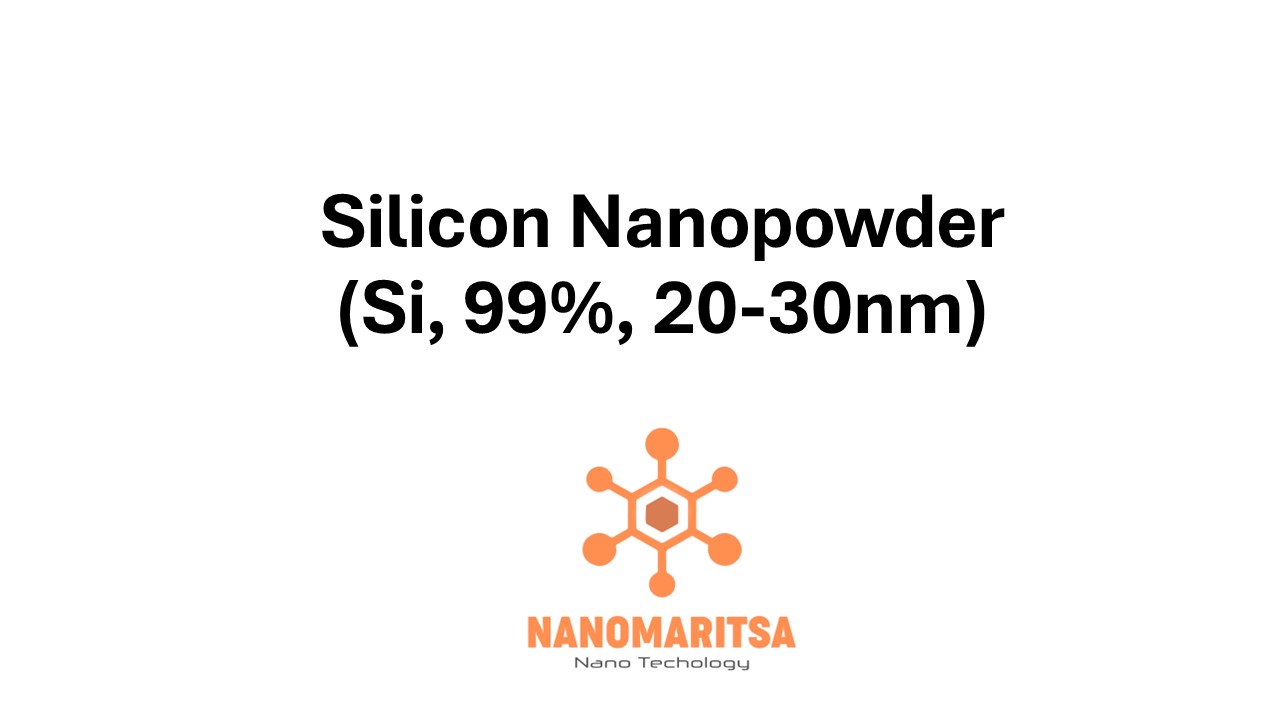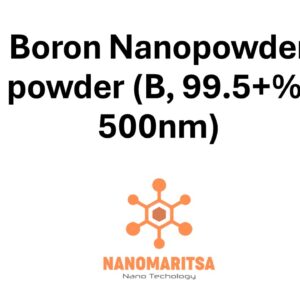Silicon Nanopowder (Si, 99%, 20-30 nm) is a high-purity material composed of silicon nanoparticles with a particle size range of 20-30 nanometers (nm) and a purity of 99%. Silicon nanopowder possesses several enhanced properties compared to bulk silicon, such as higher surface area, increased reactivity, and improved performance in various applications. These properties make silicon nanopowder highly suitable for a wide range of industrial and scientific uses, including electronics, energy storage, nanocomposites, and optoelectronics. Below is a detailed overview of the key features, properties, and applications of silicon nanopowder.
Key Features:
Silicon (Si):
Silicon is one of the most abundant elements in the Earth’s crust and is widely used in electronics, solar cells, and construction materials. At the nanoscale, silicon exhibits unique characteristics such as increased surface area, enhanced reactivity, and improved electrical properties, making it highly useful in advanced technological applications.
Purity (99%):
The 99% purity of silicon nanopowder ensures minimal contamination, providing reliable and consistent performance. High purity is crucial for applications that require precision and high material quality, such as in semiconductor devices and energy storage systems.
Particle Size (20-30 nm):
With a particle size range of 20-30 nm, silicon nanopowder has an increased surface area compared to bulk silicon. This contributes to higher reactivity, better dispersion in composites, and improved performance in energy storage and electronic applications. The small size also allows for better interaction with other materials in various processes.
Properties:
High Surface Area:
Due to its small particle size, silicon nanopowder has an extremely high surface area, which enhances its reactivity. This feature is particularly useful in catalytic processes, energy storage devices, and composite materials where surface interaction plays a critical role.
Electrical Conductivity:
Silicon is a semiconductor material, and silicon nanopowder retains its semiconducting properties, making it useful in various electronic applications, such as sensors, transistors, and photovoltaic devices. The nanopowder form allows for more efficient electrical conductivity due to better material interaction and charge transfer.
Optical Properties:
Silicon nanopowder exhibits unique optical properties due to quantum effects at the nanoscale. These properties make it valuable for applications in optoelectronics, including light-emitting diodes (LEDs), solar cells, and photodetectors. The nanopowder form can also be used in the creation of photonic materials.
Thermal Conductivity:
Silicon has excellent thermal conductivity, which is maintained in the nanopowder form. This property is useful for thermal management applications, such as heat dissipation in electronic devices or cooling systems in high-performance computing.
Mechanical Strength and Durability:
Silicon nanopowder retains the inherent strength and stability of silicon, making it durable in composite materials and high-performance applications. It can enhance the mechanical properties of materials when incorporated into various formulations, providing added strength and resistance to wear.
Reactivity and Catalysis:
The increased surface area of silicon nanopowder makes it highly reactive and an effective catalyst in various chemical reactions. This reactivity is useful in processes like hydrogenation, energy storage, and chemical synthesis.
Applications:
- Energy Storage and Batteries:
Silicon nanopowder is used in lithium-ion batteries and other energy storage devices to improve capacity and performance. Silicon anodes have a much higher theoretical capacity for lithium storage than conventional graphite anodes, making them ideal for next-generation battery technologies. Silicon nanopowder helps to improve the cycling stability and efficiency of batteries. - Semiconductors and Electronics:
Silicon is the cornerstone of the electronics industry, and its nanopowder form can be used to improve the performance of semiconductors. Silicon nanopowder is used in transistors, sensors, integrated circuits, and photovoltaic devices, enabling more efficient energy conversion, signal processing, and data storage. - Photovoltaics and Solar Cells:
Silicon nanopowder is utilized in the production of thin-film solar cells, which are lighter and more flexible compared to traditional silicon solar panels. The enhanced properties of nanopowdered silicon improve the efficiency of light absorption and energy conversion in solar cells. - Nanocomposites:
Silicon nanopowder is used as a filler material in nanocomposites to improve their mechanical strength, thermal stability, and electrical conductivity. These composite materials find applications in aerospace, automotive, and electronics industries, where high-performance materials are required. - Optoelectronics and Photonics:
Silicon nanopowder is used in optoelectronic devices, including light-emitting diodes (LEDs), photodetectors, and displays. Due to its unique optical properties at the nanoscale, silicon nanopowder can be used to create more efficient and effective light-emitting materials. - Catalysis and Chemical Reactions:
The high surface area of silicon nanopowder makes it an excellent candidate for use as a catalyst or catalyst support in various chemical reactions. It is used in applications such as hydrogen storage, chemical synthesis, and environmental remediation, where it facilitates faster chemical processes and higher efficiency. - Hydrogen Storage:
Silicon nanopowder is explored as a potential material for hydrogen storage, particularly for fuel cell applications. Its high surface area allows for better hydrogen adsorption and desorption, which is crucial for developing efficient and compact hydrogen storage systems. - Thermal Management:
The excellent thermal conductivity of silicon makes it an ideal material for heat dissipation in high-performance electronic devices. Silicon nanopowder can be incorporated into thermal management systems to improve heat transfer and prevent overheating in devices such as power electronics, LEDs, and computer processors. - Biomedical Applications:
Silicon nanopowder is being explored for use in biomedical applications such as drug delivery systems and medical implants. The biocompatibility and surface reactivity of silicon make it suitable for incorporation into biomedical devices, where it can be used to enhance the performance of implants and provide controlled drug release.
Handling and Safety:
Health and Safety Considerations:
Silicon nanopowder should be handled with care to avoid inhalation or skin contact, as fine particles can pose health risks if inhaled. Appropriate personal protective equipment (PPE), including gloves, masks, and safety goggles, should be worn during handling. Work in a well-ventilated area or use fume extraction systems to avoid inhaling fine dust particles.
Storage:
Silicon nanopowder should be stored in a cool, dry, and well-ventilated area to prevent contamination and degradation. It should be kept in tightly sealed containers to protect it from moisture, air, and other contaminants that may affect its properties.
Precautions:
Avoid generating dust or aerosols during handling, as this can pose inhalation risks. Work in a controlled environment, and dispose of any waste material according to local environmental regulations to minimize exposure and ensure safety.
Summary:
Silicon Nanopowder (Si, 99%, 20-30 nm) is a high-purity material with enhanced properties such as high surface area, increased reactivity, and excellent electrical, thermal, and mechanical characteristics. These properties make it suitable for a wide range of applications, including energy storage, electronics, photovoltaics, catalysis, and nanocomposites. Silicon nanopowder offers improvements in efficiency, performance, and material properties in various industries, from energy storage to optoelectronics. Proper handling, storage, and safety precautions are essential for ensuring the safe and effective use of this versatile material.
| Measurement (gr) | 25 grams, 100 grams |
|---|






